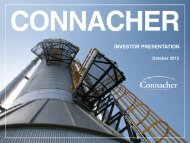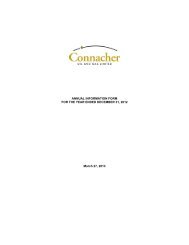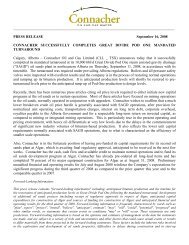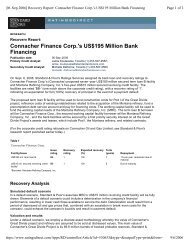ANNUAL REPORT 2011 - Connacher Oil and Gas
ANNUAL REPORT 2011 - Connacher Oil and Gas
ANNUAL REPORT 2011 - Connacher Oil and Gas
Create successful ePaper yourself
Turn your PDF publications into a flip-book with our unique Google optimized e-Paper software.
AR <strong>2011</strong><br />
PG 54<br />
Current tax expense is based on the results for the period as adjusted for items that are not taxable or not deductible. Current tax is calculated<br />
using tax rates <strong>and</strong> laws that have been enacted or substantively enacted at the end of the reporting period. Management periodically evaluates<br />
positions taken in tax returns with respect to situations in which applicable tax regulation is subject to interpretation. Provisions are established where<br />
appropriate on the basis of amounts expected to be paid to the tax authorities.<br />
Deferred tax is recognized in the balance sheet using the liability method of accounting for income taxes, on temporary differences arising between<br />
the tax bases of assets <strong>and</strong> liabilities <strong>and</strong> their carrying amounts. Deferred tax is calculated using tax rates <strong>and</strong> laws that have been enacted or<br />
substantively enacted at the end of the reporting period, <strong>and</strong> which are expected to apply when the related deferred tax asset is realized or the<br />
deferred tax liability is settled.<br />
3.9 Provisions<br />
Decommissioning liabilities<br />
The company recognizes a decommissioning liability for ab<strong>and</strong>oning petroleum <strong>and</strong> natural gas wells, related facilities, compressors <strong>and</strong> plants,<br />
removal of equipment from leased acreage <strong>and</strong> for returning such l<strong>and</strong> to its original condition, in the period in which a well or related asset is drilled,<br />
constructed or acquired. The decommissioning liability is estimated using the present value of the estimated expected future cash outflows at a<br />
risk–free interest rate. The obligation is reviewed regularly by management, based upon current costs, laws <strong>and</strong> regulations, public expectations,<br />
technology, <strong>and</strong> industry st<strong>and</strong>ards. The liability is initially capitalized as part of the carrying amount of the related property, plant <strong>and</strong> equipment<br />
The effects of changes to the liability resulting from revisions to the timing or the amount of the original estimate of the provision are reflected on a<br />
prospective basis, generally by adjustment to the carrying amount of the related property, plant <strong>and</strong> equipment. Actual ab<strong>and</strong>onment <strong>and</strong> reclamation<br />
expenditures are charged against the liability as incurred <strong>and</strong> obligations related to properties disposed are removed.<br />
The company also has decommissioning obligations with respect to certain of its refinery assets due to various legal obligations to clean <strong>and</strong>/or dispose<br />
of various component parts of the refinery at the time they are retired. However, these component parts can be used for extended <strong>and</strong> indeterminate<br />
periods of time as long as they are properly maintained <strong>and</strong>/or upgraded. It is the Company’s practice <strong>and</strong> current intent to maintain its refinery assets<br />
<strong>and</strong> continue making improvements to the assets based on technological advances. As such, the present value of such obligations is minimal.<br />
Premium on flow–through common shares<br />
Under Canadian income tax legislation, a company is permitted to issue flow–through shares whereby the company is obligated to incur qualifying<br />
expenditures related to petroleum <strong>and</strong> natural gas exploration activities <strong>and</strong> to renounce the related income tax deductions to the investors. Generally,<br />
due to the benefit of transferring the tax deduction to the investors, the shares issued on flow–through basis are offered at prices higher than the<br />
prevailing quoted prices of the shares. Accordingly, the proceeds from issuance of these shares are allocated between share capital <strong>and</strong> the liability<br />
to incur these qualifying expenditures The amounts allocated to share capital represents the quoted price of the existing shares whereas the liability<br />
represents the difference between the quoted price of the existing shares <strong>and</strong> the amount the investor pays for the flow-through shares. The liability is<br />
reversed when qualifying expenditures are renounced <strong>and</strong> reported within deferred income tax in net earnings (loss).<br />
3.10 Employee benefits<br />
Employee retirement plans<br />
The company maintains a funded defined benefit pension plan <strong>and</strong> defined contribution savings plans.<br />
A valuation of the defined benefit plan is carried out annually by independent actuaries, using the projected unit credit method to calculate the<br />
defined benefit obligation. Pension cost primarily represents the increase in the actuarial present value of the obligation for pension benefits based<br />
on employee service during the year <strong>and</strong> the interest on this obligation in respect of employee service in previous years, net of the expected return<br />
on plan assets. Plan assets are valued at fair value. The present value of the accumulated benefit obligation is determined by actuaries. The expected<br />
return on plan assets is based on market expectations at the beginning of the fiscal period for returns over the entire life of the benefit obligation.<br />
Actuarial gains <strong>and</strong> losses are recognized as income or expense when the net cumulative unrecognized actuarial gains <strong>and</strong> losses at the end of the<br />
previous reporting year exceed 10% of the higher of the defined benefit obligation <strong>and</strong> the fair value of plan assets at that date. These gains <strong>and</strong><br />
losses are recognized in net earnings (loss) over the expected average remaining working lives of the employees participating in the plan.<br />
For defined contribution saving plans, the cost is the amount of employer contributions payable for the period.<br />
Share–based compensation plans<br />
Directors, employees <strong>and</strong> consultants of the company receive remuneration in the form of share–based payment transactions, whereby those<br />
individuals render services as consideration for equity instruments. The company maintains a stock option plan, share award incentive plan <strong>and</strong> share<br />
unit plan. Share–based compensation is initially recognized over the vesting period at the fair value on the date of grant with a corresponding increase<br />
to contributed surplus for equity–settled plans <strong>and</strong> to trade <strong>and</strong> accrued payables for cash–settled plans. Equity–settled plans are subsequently not<br />
remeasured whereas the cash–settled plans are remeasured to fair value at each reporting period–end. Fair value on the date of grant is estimated<br />
using either a Black–Scholes option pricing model or the closing price of the common shares, as defined in the plans. Upon the issue of shares under<br />
the plans, the proceeds received on exercise of stock options <strong>and</strong> the amounts previously recognized in contributed surplus for the plans are credited<br />
to share capital.












